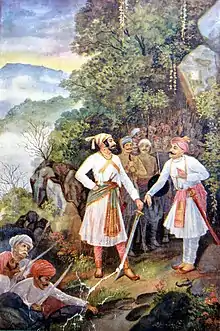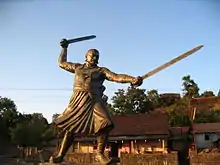Battle of Pavan Khind
Battle of Pävankhind was a rearguard last stand that took place on 13 July 1660 at a mountain pass in the vicinity of fort Vishalgad, near the city of Kolhapur, Maharashtra, India between the Maratha Warrior Baji Prabhu Deshpande and Siddi Masud of Adilshah Sultanate.[1][2] The engagement ending with the destruction of the Maratha forces, and a tactical victory for the Bijapur Sultanate, but failing to achieve a strategic victory.
| Battle of Päwan Khind | |||||||
|---|---|---|---|---|---|---|---|
| Part of the Imperial Maratha Conquests | |||||||
 A 20th century depiction by painter M.V. Dhurandhar of Shivaji and Baji Prabhu at Pawan Khind | |||||||
| |||||||
| Belligerents | |||||||
|
| Bijapur Sultanate | ||||||
| Commanders and leaders | |||||||
|
Baji Prabhu Deshpande † Fulaji Prabhu Deshpande † Shambu Singh Jadhav † | Siddi Jauhar † | ||||||
| Strength | |||||||
| 600 | 10,000 | ||||||
| Casualties and losses | |||||||
| 300 | 5,000 | ||||||
Background
In 1660, the Maratha King Shivaji was trapped in the fort of Panhala, under siege and vastly outnumbered by an Adilshahi army led by an Abyssinian named Siddi Masud. The Adilshahis were the invaders which ruled Bijapur for few years. The ruler at the time was Ali Adil Shah II. Adilshahi, having suffered several defeats from Shivaji, and even though they were at odds with Mughals, had aligned with the Mughals to temper Shivaji's ambition. Baji Prabhu Deshpande managed to engage a large Adilshahi army with 300 soldiers, while Shivaji managed to escape the siege.
Prelude
Shivaji planned to escape to the fort of Vishalgadh, which was administered by a Maratha chieftain named Range Narayan Orpe under Shivaji. Two Maratha sardars of the Adilshahi Commander Siddi Jouhar namely Suryarao Surve and Jaswantrao Dalvi had also encircled the fort of Vishalgadh simultaneously. Shivaji waited for months, planning and depleting the Adilshah's food source. He waited until he reckoned that they needed to gather more food, and then started his plan.
Shivaji, Baji Prabhu, and around 600 of their best troops, hardened mountaineers of the Maval region, would dash through the Adilshahi force at night. A man named Shiva Kashid, who resembled Shivajiin appearance, had volunteered to dress like the king and get captured. It was envisaged that this would buy some additional time due to the confusion over identity, before Siddi Masud realised the error and gave chase.

Shivaji made his escape on the dark night of 13 July, with his contingent of troops. Baji Prabhu was second in command of this contingent. The Adilshahis gave hot and rapid pursuit, with an army of 10,000. It was clear that there was no way to shake off the enemy, and that the Marathas would not simultaneously prevail over both the Moghul garrison at Vishagadh and the chasing Adilshahi army.
The only option was for a section of the Marathas to stay back and fight the larger Adilshahi forces in a rearguard action, while the rest of the Marathas would carry on to their destination. Shivaji decided that this was the inevitable choice and split his forces. Baji Prabhu Deshpande agreed to face the troops of Bijapur with 300 soldiers of the contingent. Shivaji told Baji Prabhu that he would hear the cannon fire from Vishalgadh (the destination fort), signalling Shivaji’s safety. The strategic position of Ghod Khind (Horse Pass) was chosen for the defence. It was very narrow and only a few soldiers could pass at any one time.
Battle
Bajiprabhu Deshpande occupied Ghod Khind, blocking the path of the pursuers, and made a determined defence against them. His brother Fulaji Prabhu as well as sardars such as Shambusing Jadhav were present with him. Fulaji Prabhu and Shambusing were killed after a gallant and fierce fights. Baji Prabhu was severely wounded but carried on fighting at his station. The Adilshahi army repeatedly tried to break through the defenses of the pass, but were repeatedly repulsed. The unequal battle raged for hours, with the defenders maintaining their positions, but with rapidly depleting numbers. Only a handful of Marathas survived, and around a thousand soldiers of the Adilshahi army became casualties in attempting to take the pass.
Five hours after the battle started, the cannon fire announcing Shivaj’s safe return to Vishalgadh was heard. Almost three hundred Marathas had been killed. Legend has it that a gravely injured Baji Prabhu continued engaging the enemy and held the pass, only laying down his life once he heard the sound of cannon fire. The handful surviving Marathas then retreated and disappeared in the forest as per the plan.
On the other hand Shivaji and his 300 soldiers had to break through the encirclement of Suryarao and Jaswantrao at Vishalgadh. A fierce battle ensued in which Shivaji himself fought wearing Dandpatta in his both hands. Seeing this fight, the commander of Vishalgadh fort sent help to Shivaji enabling him and his troops to reach the fort safely. Shivaji then fired cannons as a signal for Baji Prabhu to retreat.
Aftermath
Shivaji’s plan was successful. Having made his way to Vishalgadh, Rango Narayan Orpe had fresh troops at his disposal. Baji Prabhu had successfully fought the rearguard action and slowed the Adilshahis forces before they arrived at the fort having carried on pursuing Shivaji to Vishalgadh. The vengeful fresh Maratha troops carried out a blazing and bloody attack against Siddi Masood, Jasawantaro and Suryarao's forces inflicting heavy losses upon the latter when they arrived at the fort. The Adilshahi forces fled as a result of this attack.[3] One Maratha chronicler describes this fierce attack by mentioning that the 'green valleys of Vishalgadh were painted in red due to enemy's blood'. Shivaji then safely crossed the western ghats and reached his capital Rajgad via Konkan region.
Shivaji later personally visited the house of the slain Baji Prabhu, which was in the village of Kasabe Sindh in the Raigad district and honoured his family, including giving his eldest son a position of leadership and honour in the forces.
The defence of the pass of Ghod Khind by about 300 Marathas led by the Baji Prabhu Deshpande was renamed “The Battle of Pavan Khind” which in Marathi means “The Battle of the Sacred Pass”.
“The defence…,” says historian Dennis Kincaid, “has become legendary in Western India. The action is remarkable as an example of the spirit which Chhatrapati Shivaji’s leadership infused into his followers.” Shivaji’s mother, Jijabai, wept at the news of Baji Prabhu’s death. Ballads and poems have been composed in his memory, some of which are still sung today. Sri Aurobindo, the great yogi, mystic and revolutionary of the 20th century wrote a poem dedicated to Baji Prabhu, which was used as a symbol to capture the spirit of sacrifice that was required of the young men in India’s freedom struggle which was then under way.
Historian Jadunath Sarkar describes the incident in his book "Chhatrapati Shivaji and His Times" in the following way.
The siege dragged on for nearly four months; all the paths of ingress and egress were closed to the garrison. Shivaji found himself in a fatal trap. So, he wrote a secret letter to Jauhar, deceitfully begging his protection and offering to make an alliance with him. In order to negotiate for the terms he asked for a passport. Jauhar, "who was both fool and traitor," swallowed the bait; he assured Shivaji of his protection, gave him a safe conduct, and flattered himself that with Shiva for an ally he would be able to create a kingdom of his own in independence of Adil Shah. Next day Shivaji with only two or three followers visited Jauhar at midnight and was received in darbar. After oaths of co-operation had been taken on both sides, Shivaji returned quickly to the fort, and the pretended siege was continued. When the news of Jauhar's treacherous coquetting with Shiva reached the ears of Ali Adil Shah, that king burst into anger and left his capital (5 August) "to punish both the rebels." An envoy was sent to bring Jauhar back to the right path, but the mission was a failure. When, however, Ali reached Miraj and his Vanguard advanced beyond it still nearer to Panhala, Shivaji slipped out of the fort one night with his family and 2 to 3 hundred soldiers, and Panhala returned to Adil Shah's possession without a blow (about 25 August 1660.) As the Bijapur Court-poet sang in exultation, "Ali took Panhala from Salabat in a twinkle."[4]
Shivaji's escape from the fort was soon detected, and a strong Bijapuri force under Jauhar's son Siddi Aziz and Afzal Khan's son Fazl Khan set out in pursuit of him. On reaching a narrow ravine (probably near Malkapur), Shiva left 300 men there under Baji Pradhu (the deshpande of Hardis Maval) with orders to hold the mouth of the pass at all costs till the main body of the fugitives had reached Vishalgad. The Bijapuris delivered three bloody assaults on the heroic rear-guard, all of which were beaten off. But when at last the gun-fire from Vishalgarh gave the anxiously expected signal that Shivaji had reached safety within its walls, the gallant Baji Prabhu was lying mortally wounded with 200 of his followers. Baji Prabhu had done his appointed duty. The Bijapuris declined to besiege Vishalgarh, and retired to their own territory, after recovering Pavangarh and some other forts in addition to Panhala. Shivaji retained in that quarter only the forts of Rangana and Vishalgarh.[5]
See also
References
- "Shivaji, Baji Prabhu & the Battle of Pavan Khind". Hindu Perspective. 4 May 2013.
- "International film on Shivaji Maharaj for global audience". Times of India.
- Sawant, Indrajit. Parnalparvat Panhalgad.
- (Tarikh-i-Ali, 82-93 ; B. S. 353-357 ; F. R. Rajapur, Kolhapur to Sural, dated 5 June. 1660. Chit. 64 ; Dig. 175-176 ; T. S. I8b-19a.)
- [Chil. 64-65; Dig. 182-185; T. S. 19a & b; the name of Siddi Aziz is given by Duff (i. 181) only, while T, 5. reads Siddi Halal. The Persian works are absolutely silent about this retreat. Vishalgarh is 27 miles from Panhala via Malkapur. (Ind. At. 40 S. W.)]"
Further reading
- Grant Duff – History of Marathas
- Babasaheb Purandare – Raja ShivChhatrapati
- S.D.Samant – Vedh Mahamanvacha
- Kasar D.B. – Rigveda to Raigarh making of Shivaji Maharaj the great
- Bahekar Arjun – House of Sindhkhedkar Jadhavas
- J. N. Sarkar - Shivaji Maharaj and His Times